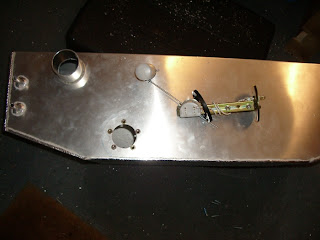Being the long Easter weekend we're going to try and get two days work on the car in and make some good progress. To start with is the front suspension.
Front Coilovers
We're meant to be fitting the propshaft first if were following Marc's build stage instructions. However I really couldn't resist getting the dampers, springs and rockers in place for the front inboard suspension as it's been lying in sealed boxes for months! This is our starting point.

The rockers need to be assembled first. We greased the rockers up and found everything was a very tight fit. To make this easier we put the rockers in the oven at 200 degrees centigrade (whislt my mum wasn't looking) and the cylindrical bearings in the frezzer for 10 minutes. After this they both slid together easily. 1 cylindrical bearing goes in each side of the pivoting point of the rocker, so in total there are 2 for each rocker. Then each side of the rocker needs a thrust washer, then a radial thrust bearing (a thin washer with bearings), then another thrust washer. This is repeated for the other sides. Now they can be fitted to their mounting brackets using m10 bolts cut to size, washers and a nyloc nut. To space these evenly we opened up the bracket by twisting some wood in between the bolt holes. This worked a treat and the washers could be slid into place instead of being jammed and unalligned. Heres the passenger side rocker in place.

To fit the spring to the damper we lowered the bump stop and removed the collar then the spring can be pushed over. After everything was greased up we fitted the lower coilver and bolt can be fitted. With the bracket spread apart like the rocker we fitted the m10 bolts with washers, a nyloc nut and special rod end spacers surrounding the rod end of the coilover. The coilover needs to be fitted with the adjuster facing inwards. Heres how the passenger side unit looks fitted.

This is the complete front assembly waiting for the pushrods to be fitted to the front lower wishbones.

Propshaft
As we dont have a reverse box our propshaft has a centre bearing to take the drive from the engine sproket and transfer it to the rear differential. To start the prop needs to be bolted to the diff. The diff uses 4xm10 fine bolts with serated washers and loctite.

The centre bearing needs to be fitted with 2xm6 cap head bolts (HT 12.9) with a spring washer and penny washer to spread the load. After making some markings with the prop in place we could drill the holes and then filed them out. To do the bolts up, access is gained from below through the aluminium floor. Being careful to avoid the fuel and brake lines we drilled a pilot hole first then a 12.5mm hole. We can now get the bolts in place then push the socket in to tighten the bolt up. Tool of the day here was using a telescopic magnetic pen to hold the bolt in place so the hex socket could locate the bolt into the centre bearing's thread.

Interior Panels
The next stage should be to fit the engine and connect it all up. Were not doing this as we're waiting on a last prop-to-diff bolt, we need to get a pipe bender to bend the fuel pipe into position as the bend is far to tight for us to do by hand now and our wiring is still hanging freely in the tunnel, needing to be secured. The plastic rear panel needs complete adjustment to fit. Room needs to be made for the tunnel and at the corners where the chassis meets the back. After a lot of filing and sawing here the result of the back.

Next is the interior side panels. We taped ours onto the outside then marked where it needed to be notched. We can't do it all now as we need the tub in place as the rear does not follow the chassis lines.

More to come tomorrow.

































